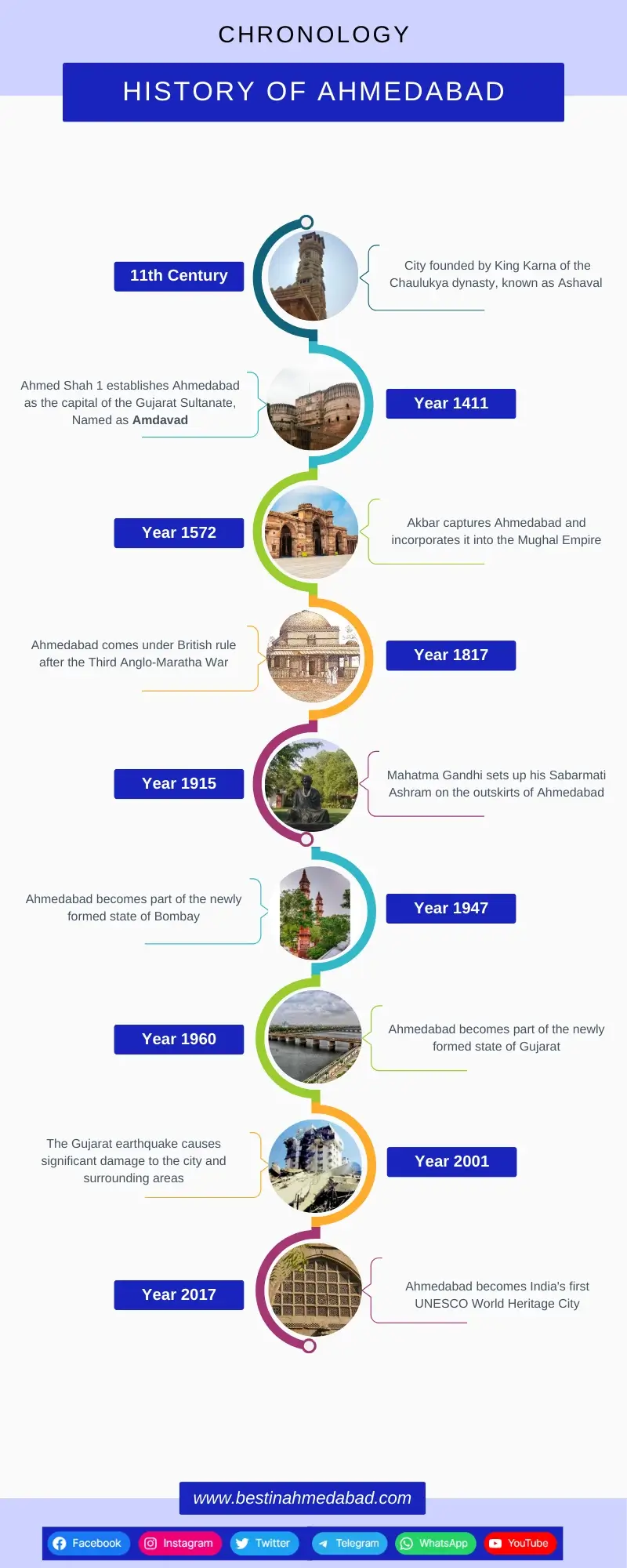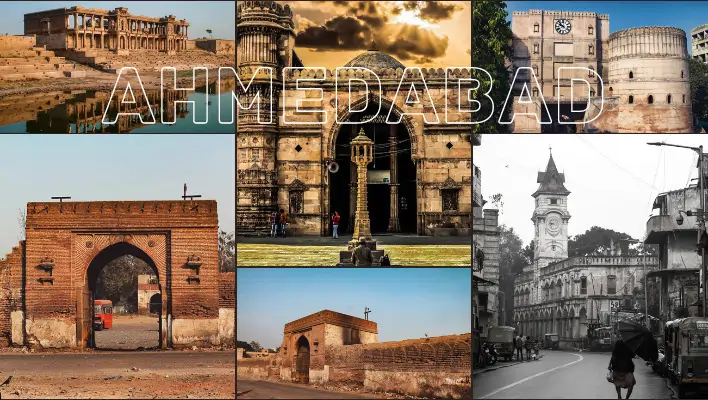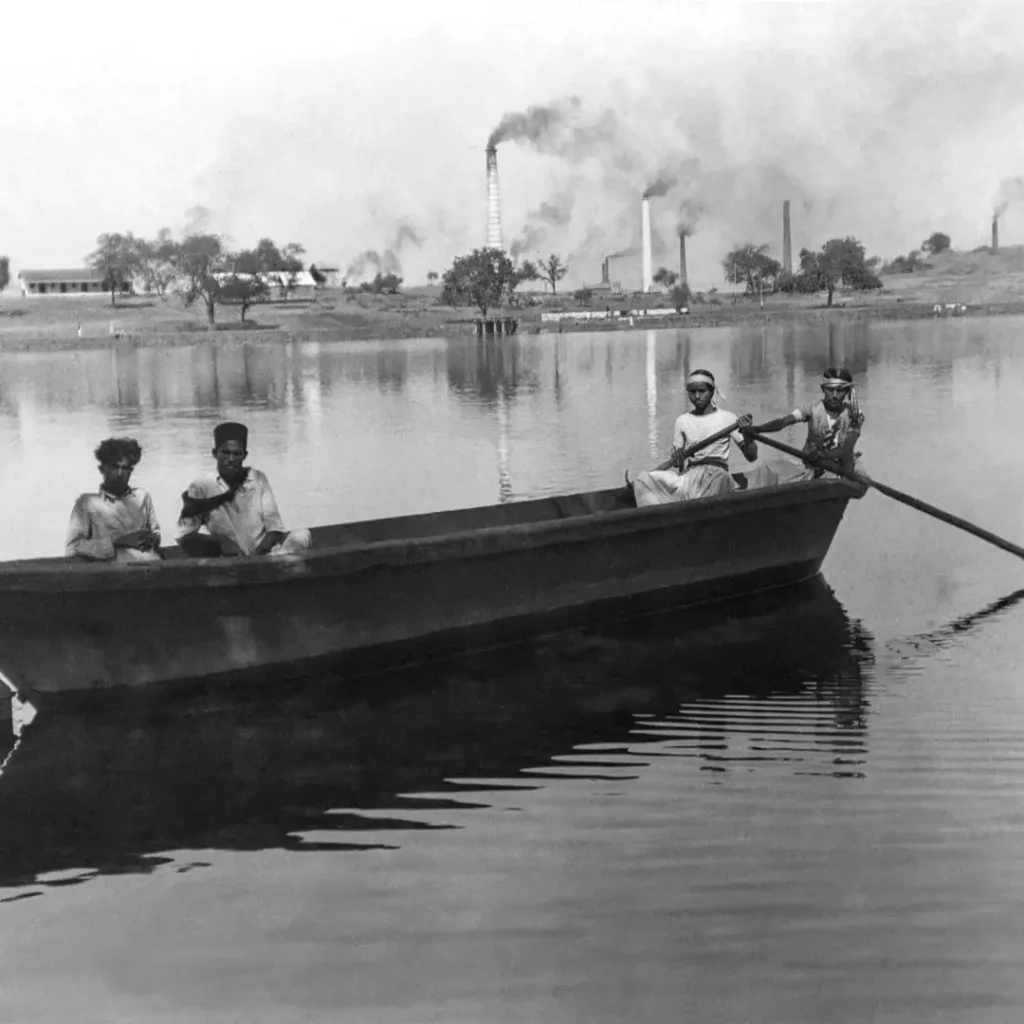Are you interested in knowing the rich history of Ahmedabad? It is located in India’s western state of Gujarat, the city has a fascinating past that dates back over 600 years. Ahmedabad has played a vital role in shaping India’s history. It started as a small town and now it has become one of the country’s most crucial commercial cities.
This article will take you on a journey through Ahmedabad’s history. We’ll explore its historical places, cultural traditions, heritage, local foods, and events. We’ll take a journey through time, starting with the city’s early years and tracing its development through the medieval period, the Mughal era, and the colonial period. Whether you are a history enthusiast or curious about this vibrant city, this article will give you a complete overview of Ahmedabad’s fascinating past.
Table of Contents
The History of Ahmedabad: From Ashaval to Modern Age
Ahmedabad is a city with a rich and fascinating history. A small town situated on the banks of the Sabarmati River, there have been many changes since its start. That has shaped its culture, architecture, and economy.
#1) The Early History of Ahmedabad: From Ashaval to Karnavati
Ahmedabad was once known as Ashawal, a small town situated on the banks of the Sabarmati River. Which was later converted into the great city of Karnavati by the Chalukya dynasty. Over the centuries, Ahmedabad saw many changes in its rulers and went through different phases of development. We will learn about the journey from Ashwal to Karnavati.
Ashaval: The Early Settlement
The city of Ahmedabad knew as Ashaval in the 11th century. It was a small town on the banks of the Sabarmati River and ruled by the Bhil king Karna. The city was strategically located on the trade route between Gujarat and Saurashtra. Which made it an important center of trade and commerce.
Karnavati: The Chaulukya Dynasty
In the 11th century, the Chalukya dynasty came to power and transformed Ashaval into the great city of Karnavati. The city was named after King Karandev 1. He was the patron of art, literature, and culture. During this time, the city saw a significant expansion of trade, commerce, and architecture. Many magnificent temples, step wells, and palaces were built, which are still standing today and attract tourists from all over the world.
#2) Ahmedabad under Sultanate Rule: The Era of Ahmed Shah
In the 14th century, Ahmedabad came under the rule of the Gujarat Sultanate. The city is named after its founder, Sultan Ahmed Shah. During this time, the city experienced a period of great prosperity and growth. The Sultanate built many mosques, palaces, and bazaars, which became the center of trade and commerce in the region. The famous Jama Masjid and Bhadra Fort were also built during this time.
#3) Mughal Rule in Ahmedabad: A Time of Prosperity and Decline
In the 16th century, Ahmedabad came under Mughal rule, and the city saw periods of prosperity and decline. The Mughals built many palaces, gardens, and markets in the city, which added to its beauty and charm. But, the Mughal rule was also marked by political instability, which led to a decline in trade and commerce in the city.
#4) British Rule in Ahmedabad: A New Era of Development
In the 19th century, Ahmedabad came under British rule and the city has seen a new era of development. The British built roads, railways, and bridges, which changed the city’s infrastructure. The textile industry also flourished during this time. Ahmedabad became an important center of textile manufacturing. The Sabarmati Ashram was established during this time, which was the residence of Mahatma Gandhi during India’s struggle for independence.
#5) The Post-Independence Era: Ahmedabad in the Modern Age
After India gained independence in 1947, Ahmedabad became a part of the state of Gujarat. The city has seen significant growth and development in the post-independence era, with the establishment of several educational institutions, hospitals, and industries. The city also saw political unrest and riots, which led to a decline in its growth and development. But in the 21st century, the city has grown a lot.
What historic events happened in Ahmedabad?

Historical Places In Ahmedabad
#1. Sabarmati Ashram
Sabarmati Ashram is a historic place in Ahmedabad, which was established in 1917 by Mahatma Gandhi. This was where he lived for more than a decade. He had completed his many social and political activities from the same. This ashram now acts as a museum, which displays many artifacts and documents related to Gandhi’s life.
#2) Sidi Saiyyed Mosque
Sidi Saiyyed Mosque is one of the most famous historical places in Ahmedabad. It knows for its beautiful stone carvings, especially the Tree of Life, which is the centerpiece of the mosque’s facade. The mosque was built in the 16th century and is an excellent example of Indo-Islamic architecture.
#3) Bhadra Fort
Bhadra Fort is a historic fort of Ahmedabad, which was created by Ahmed Shah 1 in the 14th century. The fort was used as a royal palace and there are many buildings and structures within its walls, including a mosque, a temple, and a palace. It now acts as a public park and it is a popular tourist attraction.
Book Your Heritage Places Tour With TripAdvisor
#4) Jama Masjid
Jama Masjid is a historical mosque in Ahmedabad which was built in the 15th century. It knows for its stunning architecture. Which includes its intricate carvings and unique blend of Hindu and Islamic styles. The mosque is still in use today and attracts many visitors.
#5) Adalaj Stepwell
Adalaj Stepwell is a unique historical place in Ahmedabad which was built in the 15th century. It is a five-storied step well that was used to store water and served as a resting place for travelers. The intricate carvings and beautiful architecture of the stepwell make it one of the most popular tourist attractions in the city.
#6) Sarkhej Roza
Sarkhej Roza is a mosque and tomb complex that was built in the 15th century. It knows for its stunning architecture, which includes a unique blend of Hindu and Islamic styles. The complex includes a number of buildings and structures including a mosque, a mausoleum, and a palace.
#7) Rani no Hajiro
Rani no Hajiro is a historical market in Ahmedabad which was built in the 15th century. It knows for its magnificent architecture, including its intricate carvings and graceful arches. The market is still in use today and is a popular destination for shoppers and tourists.
#8) Jhulta Minara
Jhulta Minara is a unique historical place in Ahmedabad which was built in the 15th century. It is a group of two minarets which are connected by a walkway. When one minaret is shaken, the other minaret also vibrates, creating a unique phenomenon that is still a mystery. The minarets are part of the Siddi Basheer Mosque, which was built in the 16th century and is one of the city’s most popular tourist attractions.
#9) Teen Darwaza
Teen Darwaza is a historical gateway in Ahmedabad which was built in the 15th century. It was the entrance to the Shahi Chowk and was used by the kings and queens of Gujarat. The gateway is known for its splendid architecture including its intricate carvings and graceful arches.
#10) Kankaria Lake
Kankaria Lake is a historical lake in Ahmedabad. It was built in the year 1451. It is a man-made lake that was used for various purposes including bathing and fishing. The lake is now a popular destination for boating and other water activities. Apart from this, you can take a train ride, visit a fish house, or ride in a balloon.
#11) Hutheesing Jain Temple
Hutheesing Jain Temple is a historical temple in Ahmedabad that was built in 1848 by the Hutheesing family. It is known for its stunning architecture, which includes intricate carvings and graceful arches. The temple dedicates to Lord Dharmanath, one of the Jain Tirthankaras.
#12) Calico Museum of Textiles
Calico Museum of Textiles is a historical museum in Ahmedabad that was established in 1949. It knows for its collection of textiles and artifacts which date back to the 15th century. The museum also has a library that houses many rare books and documents related to textiles and handicrafts.
More: Historical Places to Explore In Ahmedabad
Ahmedabad’s Culture and Heritage
Architecture
Ahmedabad is home to some of the most beautiful examples of Indian architecture. Ahmedabad’s old town is very special because it has a lot of old buildings with beautiful wooden carvings and designs. These buildings also have traditional courtyards, which are open spaces inside the buildings.
There are many important places to visit in Ahmedabad’s old town, like the Swaminarayan Temple, Jama Masjid, Sidi Saiyyed Mosque, Hutheesing Jain Temple, Sarkhej Roja, and Bhadra Fort. These places are very famous for their architecture, and they are definitely worth a visit.
Food
Ahmedabad is a food lover’s paradise. The city knows for its delicious street food, which includes dishes like Dhokla, Khandvi, Fafda, Thepla, Khakhra, and Dabeli. These snacks are not only delicious but also reflect the rich culinary heritage of the city. Ahmedabad is also famous for its vegetarian thali, which is a platter of mixed dishes served on a single plate.
Festivals
Ahmedabad is a city that loves to celebrate. The city is home to several festivals throughout the year including Navratri, Diwali, Holi, Rath Yatra, and Uttarayan. To experience Ahmedabad’s festivals and enjoy the city’s true beauty, it’s a great idea to visit during festival time. This way, you can see the festivals up close and get a feel for the city’s culture and traditions. So, if you want to see Ahmedabad at its best, plan your visit during one of its many colorful festivals!
Textile Heritage
Ahmedabad is also known for its rich textile heritage. The city has been a center of textile production for centuries. The fabrics made in Ahmedabad are famous for their beautiful designs and high quality. If you want to see and buy some of these amazing fabrics, you should check out some of the cloth markets in Ahmedabad. Some of the best ones are Law Garden Market, Dhalgarwad Cloth Market, Ratan Pol Market, and Rani No Hajiro Market.
Museums
Ahmedabad is home to several museums that showcase the city’s rich cultural and historical heritage. The Calico Textile Museum is a must-visit for anyone interested in learning about the textile history of Ahmedabad. Other museums in Ahmedabad include Sanskar Kendra Museum, Science City, and Auto World Vintage Car Museum.
Education
Ahmedabad has always been a center for education and learning. The city is home to some of India’s top educational institutions, including the Indian Institute of Management, the National Institute of Design, and the Gujarat University.
Business and Industry
Ahmedabad is a major center for business and industry in India. The city is home to several large corporations, including Adani Group, TATA consultancy services, Torrent, and Intas Pharmaceuticals. Ahmedabad’s thriving economy and entrepreneurial spirit have made it one of the fastest-growing cities in India.
Parks and Gardens
Ahmedabad is a city that loves its green spaces. There are lots of parks and gardens where people can go to relax and enjoy the outdoors. One of the most popular places is the Sabarmati Riverfront, which is a great spot for jogging, cycling, and picnics. Other popular parks in Ahmedabad include the Law Garden, Kankaria Lake, and the Victoria Garden.
Sports
Ahmedabad is a city that loves sports. The city has several sports stadiums including the Narendra Modi Stadium, which is one of the largest cricket stadiums in the world. The stadium has hosted several high-profile cricket matches including the 2011 Cricket World Cup. Ahmedabad is also home to the Gujarat State Football Association, which promotes football in the state. Apart from this, sports competitions like swimming, judo, and kabaddi keep happening here.
Religious Diversity
Ahmedabad is a city that celebrates religious diversity. The city is home to several important religious sites including Hatkeshwar Temple, Dada Bhagwan Temple, Sarkhej Roja, Jama Masjid, Swaminarayan Temple, Bhadrakali Temple, ISKCON Temple, and St. Xavier’s Church. What’s cool about Ahmedabad is that people of different religions live there and get along well. This means that there’s a lot of peace and harmony between different religious groups in the city.
Heritage Walks
One of the best ways to explore the culture and heritage of Ahmedabad is by taking a heritage walk. These guided walks take visitors through the city’s historic old town, which showcases its rich architectural heritage and cultural significance. Some popular heritage walks in Ahmedabad include the Old City Heritage Walk and the Textile Heritage Walk. You can book a trip for heritage walks online through Trip Advisor and Ahmedabad Heritage Walk’s official website.
Exploring Ahmedabad’s Local Cuisine: A Culinary Journey
The Famous Gujarati Thali
When it comes to the cuisine of Ahmedabad, the first thing that comes to mind is the famous Gujarati thali. The thali consists of several dishes, everything from sweet to savory, served in small portions. A typical Gujarati thali includes items such as roti, dal, rice, vegetables, curry, papad, and pickles. One of the most unique things about Gujarati Thali is the way it serves. Dishes are served in a specific order, starting with a sweet dish and ending with rice and dal.
Other Local Delicacies
Apart from Gujarati Thali, there are many other local dishes in Ahmedabad which are a must-try for food lovers. Some of the popular dishes include Khaman Dhokla which is a steamed snack made of gram flour, and Fafda-Jalebi which is a crispy snack served with sweet and sour chutney. Another popular dish is Undhiyu which is a mixed vegetable dish cooked in an earthen pot and usually eaten during the winter season.
Influence of Jain and Hindu Dietary Restrictions
The food in Ahmedabad influences the Jain and Hindu communities. Jains are strict vegetarians and have rules about what they can eat. They can’t have things like potatoes, onions, or garlic because these grow underground. So, lots of restaurants in Ahmedabad have special Jain versions of their dishes, where they use different veggies instead.
Similarly, Hindus also have dietary restrictions that differ depending on their region. For example, people of the Vaishnava community do not consume onion and garlic. If you have special dietary needs in Ahmedabad, don’t worry! Lots of restaurants there have separate menus for customers who need them. This is helpful for people who have dietary restrictions, like Jains who don’t eat certain veggies. So, you can still enjoy all the yummy food that Ahmedabad has to offer, even if you have special dietary needs.
Popular Food Joints
Ahmedabad has lots of great places to eat, including some popular food joints that food lovers shouldn’t miss. Manek Chowk is a famous night market that serves all kinds of street food. And if you have a sweet tooth, you’ll definitely want to check out Kandoi Bhogilal Mulchand, which knows for its yummy sweets and snacks.
FAQs
Q.1) Why Ahmedabad is famous?
Ahmedabad is famous for several reasons, including its rich history, cultural heritage, and significant contributions to the Indian economy. It knows for its well-preserved historical monuments such as the Sabarmati Ashram and the Sidi Saiyyed Mosque. Ahmedabad is also famous for its textile industry, which has been a major contributor to the city’s economy for centuries. Additionally, it is renowned for its delicious street food, vibrant festivals, and warm hospitality.
Q.2) How old is Ahmedabad city?
Ahmedabad is a historical city in India that dates back to the 11th century when it was founded by King Karandev I of the Solanki dynasty. But, the modern city of Ahmedabad was established in 1411 by Sultan Ahmed Shah, who named it after himself. So, the age of the modern city of Ahmedabad is over 600 years old.
Q.3) What are some must-visit places in Ahmedabad for history enthusiasts?
Ahmedabad has some amazing places for you to visit. Sabarmati Ashram, Jama Mosque, Sidi Saiyyed Mosque, and Bhadra Fort are some of the places you should definitely check out.













